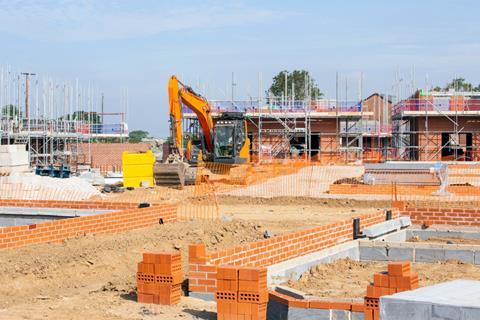Official figures for May show 0.4% drop driven by private housing decline
New-build construction work in May fell to its lowest level in almost a year in the wake of falling private housing and commercial workloads, according to the latest official figures.
Monthly new-build output dropped 0.4% on April, pushing seasonally adjusted construction output overall – including repair and maintenance work (R&M) – down 0.2%, with £15.4bn of work done in the month.

For new-build construction alone, the £9.16bn of work carried out was the lowest figure reported in the dataset since June last year, when £9.09bn of new-build work was carried out.
The drivers of the decline were a £51m fall in private housebuilding work in the month, equivalent to a 1.6% drop, and a £32m fall in private commercial work. These falls were partially offset by a big rise in infrastructure build work, up £35m.
The housing output figure is 14.6% below the equivalent monthly number from May last year.
The decline in housebuilding work comes amid growing concerns over the impact of rising interest rates on the sector, with Barratt today predicting a near 25% drop in output over the coming year, and purchasing managers reporting seven months of declining activity already in the sector.
The RICS yesterday reported that buyer demand for homes had fallen in June to its lowest level since the immediate aftermath of Kwasi Kwarteng’s mini-Budget statement, with average mortgage rates this week topping the levels seen at that time.
R&M work was flat on the month, with £1m less work carried out in May than in April. In total, four out of the nine sectors across new-build and R&M recorded declines in output.
However, despite the drop in May which included the additional bank holiday for the coronation of King Charles, the amount of work carried out in the three months to May was still slightly up on the prior three-month period, registering a 0.2% rise.
Noble Francis, economics director at the Construction Products Association, said in response to the figures that the drop in output from housing was likely to get worse, given that the figures represented a period in which mortgage rates were lower and the market looked like it was modestly recovering.
He said on Twitter: “Private housing output in May 2023 being 14.6% lower than a year ago was before recent sharp mortgage rate rises (in June and July) that has led many major housebuilders to go on a ‘summer pause’ in new starts until they see what the levels of new housing demand are likely to be once mortgage rates (and approvals and transactions) settle.
“As a result, private housing output is likely to fall significantly further in the rest of 2023.”
Fraser Johns, finance director at contractor Beard Construction, said: “While some sectors are feeling the pressure, particularly private housing, and uncertainty in the wider economy may be inhibiting some clients from pulling the trigger on new work, this is certainly not the entire industry picture.
“It is certainly not normal trading conditions, but it is proving less volatile than the wider industry picture may represent. For us and many firms across the industry, it’s all about remaining agile, minimising pressure on cost plans and responding to the opportunities still available.”



























No comments yet